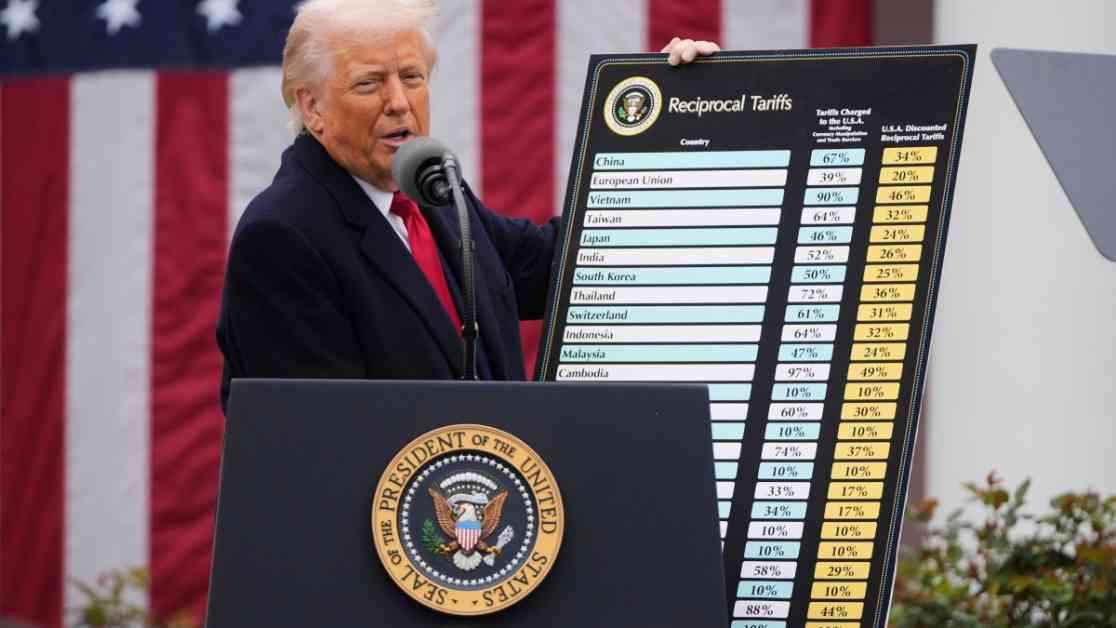President Trump recently made headlines with his announcement of new tariffs during a speech in the White House Rose Garden. As he held up a perplexing chart detailing the tariffs that other countries impose on the U.S. and the corresponding tariffs the U.S. intends to levy against them, he emphasized the principle of reciprocity. Trump declared, “Reciprocal. That means they do it to us and we do it to them. Very simple. Can’t get any simpler than that.”
In his address, Trump outlined a plan to implement a “minimum baseline tariff of 10%” on all imported goods, while also indicating that the U.S. would impose tariffs on other countries at a rate equal to half of what those countries charge for U.S. goods. According to the chart displayed by Trump, this could result in tariffs as high as 50% on imports from certain countries.
The first column of the chart purported to show “Tariffs Charged to the U.S.A.” as a percentage. However, upon closer examination, it was evident that the figures were significantly higher than the average tariff rates reported by the World Trade Organization. The small print below the “Tariffs Charged” category acknowledged that the numbers included “Currency Manipulation and Trade Barriers,” factors that are challenging to quantify, yet not the basis for the White House’s calculations.
Fact vs. Fiction
The Office of the U.S. Trade Representative (USTR) provided a fact sheet outlining the methodology behind the reciprocal tariffs. The USTR’s approach was to compute the tariff rate needed to balance bilateral trade deficits between the U.S. and its trading partners. This method assumed that persistent trade imbalances resulted from a combination of tariff and non-tariff barriers, with tariffs serving to reduce imports directly.
While the USTR acknowledged the complexity of calculating trade deficit effects for individual countries, it proposed a formula that approximated the tariff level necessary to eliminate bilateral trade deficits. This involved dividing the trade imbalance between the U.S. and a country by the total U.S. imports from that nation.
For instance, the chart indicated that the European Union (EU) imposed a 39% tariff on U.S. imports. Trump suggested that the U.S. would charge countries half of their tariff rate as a reciprocal measure. However, critics pointed out that the EU’s actual trade-weighted average tariff rate was substantially lower at 2.7%. They argued that the White House’s calculations were flawed and not reflective of the true trade barriers faced by the U.S.
Expert Insights and Critiques
Economists and trade experts expressed skepticism regarding the White House’s methodology for determining reciprocal tariffs. Kimberly Clausing from the Peterson Institute for International Economics highlighted the flawed nature of the calculations, emphasizing that the approach vastly overstated trade barriers. The experts contended that the focus on goods alone neglected the trade surplus the U.S. enjoyed in the services sector, skewing the results significantly.
In response to the USTR’s reliance on academic studies to support its tariff calculations, researchers raised concerns about the assumptions and oversimplifications inherent in the formulaic approach. They cautioned that the proposed tariffs could have unintended consequences, including trade disruptions and other harmful effects.
Despite the administration’s claims that tariffs would generate significant revenue and reduce taxes, analysts warned that the tariffs could ultimately lead to higher costs for American consumers. The impact of tariffs on trade balances and economic growth remained a subject of debate among experts.
As President Trump touted the benefits of his tariff policies and predicted a robust economic revival, critics continued to challenge the validity of his trade arguments. The ongoing discourse highlighted the complexities of international trade and the need for evidence-based policies to address trade imbalances effectively.
FactCheck.org relies on contributions from readers like you to continue providing accurate and unbiased analysis. Your support helps us maintain our commitment to factual reporting. To make a donation, please visit our website or send a check to the address provided. Thank you for your generosity and dedication to the truth.














